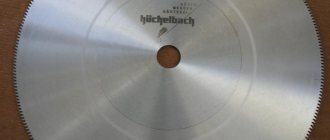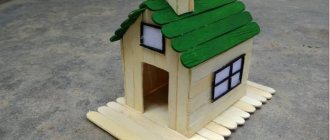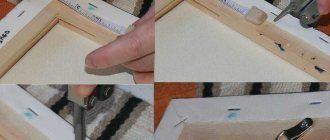Despite the abundance of various furniture in stores, a simple stool has been and remains a fairly popular piece of furniture in the home. It is especially relevant if the apartment is decorated in a rustic style - in a kitchen with such a design, an ordinary stool will be simply irreplaceable.
But it’s not easy to buy a quality product now, so it’s easier to make it yourself. How to make a stool with your own hands from wood? The drawing, diagram and step-by-step instructions are in this material.
How to make a stool with your own hands from wood
Simple round stool
To make an original wooden stool with a round lid you need:
- Before you make a simple stool from wood with your own hands using a hacksaw and a set of chisels, you will need to mark the bars.
- Cut out blanks for legs and connecting jumpers, on which it is necessary to provide protrusions.
- Connect the frame elements using the technology used when assembling a square stool with your own hands from wood.
- Mark with a compass a circle corresponding to the diameter of the lid on a sheet of thick plywood, a monolithic board or a package assembled from several plates.
- Cut the workpiece with a hacksaw or jigsaw, and then process the edges with an abrasive tool.
- Place the cover on the base and finish the surfaces.
A simple round stool is a very comfortable piece of furniture.
For country houses, they use the technology of manufacturing round stools of a simplified design. Instead of separate legs, use 2 sheets of plywood or chipboard with connecting grooves. The supports are joined at right angles, and then a round lid is attached on top using wooden pins and adhesive. To increase rigidity, screws and metal corners are installed.
We use scraps and new sheets
In order to make a stool for your kitchen, it is not necessary to buy new sheets of chipboard. You can use scraps or borrow elements of old furniture (unnecessary, of course). First, transfer the dimensions of all parts onto chipboard sheets. All lines should be clearly visible so that it will be convenient to cut blanks along them later.
If you are using an electric jigsaw, it is best to choose a bit with small teeth. The speed should be maximum. After cutting, all edges must be cleaned with sandpaper. Burrs and chips are not allowed.
The jumper is attached to the racks using self-tapping screws - this is the easiest way. But you can use a tongue-and-groove connection.
At the same time, you make grooves in the racks using a drill. The groove is aligned with a file so that the tenon fits as tightly as possible. But it is not necessary to use this type of connection; it is enough to fix it with self-tapping screws or Euroscrews. Carefully study the design features and photos of chipboard stools. You can make any design with your own hands, but it’s best to start with the simplest ones.
Mark the places and make guide holes in them. Then you connect all the elements. To improve the appearance of the stool, it is recommended to use countersunk drills. But if this is not available, then it is allowed to use a simple one corresponding to the diameter of the cap. In order to cover the screws, install plugs.
Manufacturing procedure
Is it difficult and how to make a stool with your own hands? First you need to decide on the drawing and choose the optimal design. The next stage is preparing the material for manufacturing. Wood, chipboard or plywood must be dried and checked for defects
Then the workplace is set up, special attention is paid to lighting
As an example, we can consider how to make a stool from chipboard.
Production stages:
Sheet marking. This is necessary for the formation of blanks. Beginners are recommended to make patterns from paper or thick cardboard. This way you can avoid sizing errors.
It is important to consider the kerf width tolerances. Formation of blanks. The optimal tool is an electric jigsaw
The edges need to be sanded with sandpaper or a sanding machine. Fastening components. Depending on the design, you can use the slotting method, joining with furniture corners or using wooden tenons. If the structure is made of wood with your own hands, you can use confirmations. This screw fastener secures various components well and improves stability. Painting and varnishing. The finishing surface can be matte or glossy. If it is important to preserve the original texture, use translucent or transparent varnishes. Acrylic compounds are most often used. Additions. Often special shock absorbers are installed on the legs. They minimize the appearance of scratches on the floor and reduce noise when moving furniture.
Some general information and history
A stool, or, as this piece of furniture is commonly called, a stool, is a product designed for sitting, which has neither a back nor armrests, and can accommodate only one person. That is, the stool has only the seat itself, as well as support legs connected to each other by drawers and legs. There are usually 4 legs, but some types of stools may have 3 or 1 leg.
The dimensions of the classic stool are standard. The seat has a width of about 30-45 cm for an adult, and for a child this parameter is approximately 25-28 cm. The height of the product is on average 42-48 cm for an adult, and 26-28 cm for a child.
Scheme of a classic stool
The history of the stool goes back many centuries, if not millennia. The first product in history was created according to the principle of building a dolmen, when one was placed horizontally on two vertically installed stones and acted as a roof. In general, the history of this modest piece of furniture officially began with Ancient Egypt (about 5000 years ago). The first stools were very low, which is directly related to the short stature of people of that time (men of that time rarely exceeded the height mark of 159 cm).
On a note! Stools served a variety of purposes at the time. Even the appearance of children, according to some frescoes, took place on a stool.
For a long time, an ordinary stool was considered an attribute of the interior of the rich. Even pharaohs sat on it, although soft pillows were placed on the seat. A little later, the stool “evolved” into the prototype of a chair - it had a small back.
Design features of the stool
Also, stools conquered Rome and survived until the Middle Ages, not disappearing even in the midst of wars. Medieval products were assembled without nails and had wide legs. Then stool-chests began to appear in which something could be stored. The same seats with storage drawers appeared in Rus'.
It’s interesting that for a long time she could only sit on chairs and stools. The low-born were located directly on the floor and ground, without experiencing any discomfort. The monks also contributed to the development of furniture in their time, thanks to whom stools began to be used for sitting at desks. To facilitate intellectual work, a rotating stool was invented, which appeared around the 14th century.
Antique stools
Thus, the stool, changing, survived until the twentieth century, and then to the present day. And it still continues to be in great demand, remaining a convenient and functional product. So, it is convenient to sit on it at the table; if necessary, it can be pushed under it so that it does not interfere. And in some cases, you can safely stand on a stool to reach something from above. This is a very stable, practical and interesting product, despite its apparent simplicity and modesty.
On a note! In Soviet-era schools, almost all boys made stools during labor lessons. And the girls coped with this task perfectly if necessary. Such lessons helped lay the foundations of carpentry skills.
How to make a three-legged stool
Decoration
If we talk about decorating stools, there are a lot of ideas that will allow you to turn them into something unique and interesting. Ideas for decorating such products can be divided into 3 large categories:
- woodworking;
- use of various types of pillows;
- the use of various types of capes.
If we talk about the first category, then a very popular type of decoration is the creation of antique stools. For this purpose, there is a special coating for wood, as well as its special processing. Carved models of this type, which are made by professionals, have a fairly high price. But it is not always possible to make such a stool yourself.
But the use of various kinds of pillows is one of the most commonly used methods of decorating such furniture. In addition to the fact that various original pillows make the stool truly unique and interesting, it is also soft and comfortable. After all, often the problem with any stool is that you can’t sit on it for a long time due to the hard surface. And so this problem is solved, and you can enjoy sitting on such a beautiful chair. Another decoration option is the use of various capes. Well, here everything is limited only by the imagination of the owner of such furniture and his financial capabilities. As you can see, today there are many options for decorating wooden stools made with your own hands.
Shapes and sizes
In fact, most stools have a fairly classic shape. The seat is typically flat and either round or square, although concave designs are also present today. There can be four, two, three or even five legs. They are made as usual straight, twisted or crossed.
In straight structures, by the way, the edges can also be either sharp or rounded. As you might guess, the length of the legs also varies - the highest is a high bar stool, and the lowest are wooden stools intended for small children.
This type of furniture has different dimensions, which allows any buyer to choose a model to suit their specific parameters.
For comfortable use, the height of the stool should correspond to the distance from the floor to the knees of a standing person, but the height of the kitchen table should also be taken into account. On average, this figure varies from 42 to 65 centimeters. The width of the seat is selected individually, but it must be at least 36 centimeters.
Tools and materials
So, in order to make a wooden chair yourself, you need to prepare a number of tools and materials. If we talk about tools, we should name:
- plane;
- Circular Saw;
- drill;
- screwdriver;
- wood hacksaw;
- milling cutter;
- roulette;
- pencil;
- clamps.
If we talk about materials, then you will need to have on hand:
- screws;
- furniture glue;
- sandpaper;
- stain or drying oil;
- masking tape;
- cardboard for stencil;
- dowel or lumber.
Here it should be understood that the choice of wood and the final processing technique will determine the ability of the chair to cope with the effects of natural factors, its stability, reliability and ability to withstand physical stress. For some reason, many people choose chipboard to create a chair, although this material is completely unsuitable for chairs. And especially for garden-type models. The reason is simple - extremely low resistance to moisture. And the strength of chipboard models will be lower than that of solid wood or timber models.
But natural wood, although not the most affordable material, is environmentally friendly and completely harmless. It will be the best solution if you want to make homemade chairs with your own hands. Before starting work, you should inspect the boards and bars for defects - cracks and knots. After this, the material is polished, protective materials are applied to it, and assembly is performed. If we talk about wood, then it would be best to take alder, ash, birch, and oak for such purposes.
There are two reasons here. The first is the presence of an unusual fiber pattern. The second is the high wear resistance of a product made from these materials. And the durability of such products will be high. The only drawback will be deformation under the influence of moisture and low resistance to fire. And one more important point that should also be prepared is drawings and diagrams. This issue should be decided when it is already known what material the furniture will be made from. There are several options to solve this problem:
- make a drawing with your own hand, which will indicate the dimensions and features of this chair;
- do it on a computer;
- download the finished version on one of the specialized sites.
Which option is better to choose will depend on your drawing and computer skills.
Real folding chair
The drawings of folding chairs with a backrest have differences, but they are small, since the principle of all designs is similar, and the manufacture of such furniture cannot be called super complicated.
If we consider all the elements, the chair consists of:
- Pairs of rear short legs 20x40x475 mm. Often, diagrams provide for an upper crossbar and a leg - lower jumpers for greater strength, but in this model they are absent in the picture (1).
- Two front legs (2), the upper part of which acts as a backrest (20x40x837 mm).
- Two parts - backrest crossbars and a lower leg (3). All three are 20x70x403.
- Two side drawers for the seat (5) - 20x40x470 mm.
- Seat parts (6) - 6 elements 20x50x440 or a solid plywood sheet (15x440x470 mm).
In addition to the main parts, you will need dowels (15x30 mm), glue, bolts with nuts and washers (diameter 8-10 mm, length - 50 mm), self-tapping screws. You can’t do without tools, you need:
- jigsaw or circular saw;
- router for rounding corners;
- Sander;
- miter box.
"Preparation of blanks"
All elements are cut out, polished, and the corners are rounded with a milling cutter. The lower parts of the front legs are cut off, the angle is the same as in the previous “recipe” - 30°, so a miter box is necessary here too. The next stage is marking the grooves of the long legs. There are three of them for each part - 2 for the back and one for the leg. The grooves are cut with a router or drill (drill - 9 mm), then the holes are combined using the same chisel and ground.
On the bars rounded at the bottom for the drawers, holes are made for dowels; their depth and diameter are 15 mm. These fasteners, intended for the grooves of the rear legs, are placed on glue. In the middle of the drawer, drill a through hole for screws. They will attach the front legs. Finished parts are polished.
Then prepare 5 identical parts. Two of them will be the back, one will be the leg of the front supporting elements, 2 more additional ones, not shown in the picture, are the leg of the rear legs and the crossbar, which gives them rigidity. Spikes are formed in these parts, their dimensions are 9x15x50 mm. They are cut out with a router or jigsaw, flaws are corrected with a knife, and smoothed with sandpaper.
The hind legs are prepared. They are rounded at the top and markings are made for three grooves: the middle one for the dowels in the drawers, the upper and lower ones for the lintel and prong, respectively. Before cutting the grooves, check the symmetry of the markings of both elements.
Assembly sequence
This stage, of course, always starts with the seat. The boards intended for it are distributed evenly among the sides, not forgetting about their parallelism and perpendicularity to the side parts. Having made the markings, they are fixed with glue and placed in clamps. After it dries, 2 holes are made in the edges of the boards for fastening to the drawers, and self-tapping screws are screwed into the countersunk holes.
Assemble the rear frame. Having installed it in the dowels protruding from the drawers, they simultaneously glue the leg and the upper jumper. The structure is tightened with clamps, waiting for the joints to dry. The top crossbar and leg are glued to one front leg. Afterwards it is fastened to the drawer with a screw. Then the second leg is attached to it with glue, which is also connected with a screw to the side of the seat. The glued and screwed chair is again fixed in clamps until completely dry.
Despite the fact that it is not at all difficult to build a folding chair with your own hands, a drawing is a necessary condition. It is better to find it rather than “invent” it yourself, since ready-made circuits have been tested, reliable and accurate.
You can also check out the prices for ready-made folding chairs:
How to build a solid folding chair, see this video:
This is interesting: Wardrobes in the living room the size of the entire wall: placement features
Tips for safe use
When using any lifting mechanisms, it is important to remember several rules:
- Before installing the structure, make sure it is suitable. Inspect for damage, loose fasteners and damaged rubber parts and supports.
- Place the product on a flat surface.
- If you are working on the site, check that there are no holes or stones under the legs.
- Follow the manufacturer's installation recommendations. Extension ladders, for example, need to be installed at an angle of about 75 degrees.
In the assembled product, check all fasteners, clamps and adjusters
It is necessary that everything is tightly latched and closed. Please pay attention to the maximum permissible weight for the product. If there are no rubberized pads on the steps, try to work in non-slip shoes. Store the stepladder according to the manufacturer's recommendations.
To learn how to make a ladder chair with your own hands, watch this video.
Types of furniture products
Stools can differ in size and appearance, as well as in the materials from which they are made. So, most often they are made from ordinary wood, but there are stools made of metal, plastic, and also those created by combining various materials (for example, the seat can be wooden and the legs can be metal). It is worth noting that, if desired, the seat of the stool can be made soft or simply covered with fabric to give the product a beautiful appearance or achieve a certain level of comfort when sitting on it. The legs may also differ in appearance. There are products with simple, even legs, and there are those whose lower part is a real work of art. It can be patterned, carved and decorated in every possible way.
Products made from natural wood are strong and durable, and also have an original design, which is why they do not lose their popularity
On a note! There are stools that differ in appearance depending on the purpose of their use.
Table. Types of stools.
| Type | Short description |
| Kitchen | This is the simplest and most common option that can be found in many apartments. These stools are used in the kitchen. |
| Bar | Such stools are distinguished by a large seat height, and for a more comfortable position, they have a special foot support underneath. They are used in bars for comfortable seating at a high bar counter. |
| Tourist | This stool is usually foldable and quite durable. Its seat is usually fabric, but is made of durable material that can withstand changes in humidity and temperature. The legs are made of aluminum, which is the lightest type of metal. |
| Musical | This stool is needed specifically by musicians to play musical instruments. It can change its height and also rotate around its axis. |
Children's stool
On a note! In addition to these types of stools, there are also specialized products that differ in certain characteristics (for example, strength, height, etc.). These include children's stools, which are very small in size.
Other decor ideas
If there is a tapestry on the cover with an image in its middle, you can place a floral pattern with flowers. Due to the fact that the combinations of shades look dim, this option will not be pretentious, but stylish.
The seats can be decorated with embroidery on the cover. A large flower made using the satin stitch technique will look nice like a tapestry. An interesting option is an ornament along the perimeter or an abstract type of picture. They use strong, non-fading threads that will not wear out due to frequent washing.
Knowing how to make a wooden stool with your own hands, you can create beautiful furniture and save money.
Review of drawings
At the first stage, you need to decide on the sizes. Seat dimensions vary from 300*300 to 450*450 mm. If this is a children's version - 250*250 mm. The height directly depends on the height of the person and can range from 260 to 480 mm. In exceptional situations, a children's chair can be 200 mm high. But this is rarely done. In some cases, high stools will fit at the bar counter.
There are many stool drawings - for beginners and professionals. In the first case, it is recommended to choose simple designs. People with carpentry skills opt for folding or combined (ladder, box) assembly schemes.
All drawings are conditionally divided by complexity:
- The number of parts varies from three to five. The more components there are, the more stable the structure will be. But this affects the complexity of production.
- Material of manufacture. The easiest way is to make a stool from plywood, but in the future difficulties may arise with its operation - the influence of moisture and temperature changes will affect the appearance and reliability. It is recommended to choose chipboard or timber, wooden board.
- Available tools. To make a wooden stool you will need a minimum of tools: a tape measure, a ruler, a wood saw, sanding paper, a drill or a screwdriver.
For beginners, it is recommended to try a simple design consisting of three elements. It is done relatively simply at home.
What do you need for work?
Regardless of the type of structure being manufactured, work must always begin with a drawing of the future project. It is advisable to consider several options so that you have something to compare with and ultimately choose one. The preparatory stage does not end here. You also need to take care of the tools.
Woodworking tools
So, to make a stool you need to prepare the following:
- softwood boards;
- furniture stapler;
- set of self-tapping screws;
- seat upholstery material;
- PVA glue for working with wood;
- sandpaper with different grain sizes;
- hand saw or jigsaw;
- plane;
- screwdriver and electric drill;
- safety glasses and work gloves.
Hand wooden plane
Be sure to prepare paint and varnish materials and decorative finishing products. It is also necessary to purchase various stencils, rollers and brushes for painting the finished product. Once everything you need is at hand, you can get to work.
How to make a simple rectangular stool?
Having dealt with the design, it’s time to start actual manufacturing. Let's look at a few examples. The simplest is the rectangular model. Good for small rooms.
Technical characteristics of this design:
- Hallways 2020: TOP-200 photos of the best new products and modern design. Options for the ideal combination of color and style of furniture in the hallway
- Do-it-yourself door finishing: 115 photos of the best options for entrance and interior doors
- DIY cornice: a detailed description of how to design and decorate a stylish interior element (80 photos)
The height of the finished product is from 44 to 50 centimeters;
- Leg section: 3.5 x 3.5 or 5 x 5 centimeters;
- Drawers – 29 x 6 x 2 centimeters;
- Spacers – 29 x 2 x 2 centimeters;
- “Crusks” – 6 x 6 x 2 centimeters.
All details must be prepared in advance. You can make them yourself or order them from a carpentry workshop. If you want to get an original and beautiful product, then you should make curly or turned legs.
Then comes the crucial stage. You need to measure exactly where to make the holes for the fasteners. The dry assembly method is used. Thus, you can even do without glue.
Manufacturing
As mentioned above, there is nothing particularly difficult about making your own inexpensive but attractive chipboard stool. The main thing is to first draw up detailed drawings and indicate on them all the dimensions of the future structure. Having such an “action plan” in hand will make your work much easier and more convenient, because at any moment you will be able to check whether you are doing everything correctly.
Preparation and cutting of material
The first stage of making a stool from chipboard yourself will be preparing and sawing the specified material that imitates wood. Different craftsmen use different tools for this, but an electric jigsaw is considered more convenient and practical - it’s easier to work with. It is advisable to use a tool with short teeth. The jigsaw should work at the highest speed - this is the only way all the cuts will be clean and even.
Having at hand a template (a detailed drawing with all the details) of the future stool, you can proceed to its creation. The paper or cardboard blank must be attached to the wood boards and outlined with a pencil. This way, it will be easier for you to cut out all the parts efficiently and accurately. All small irregularities remaining after cutting should be removed using sandpaper or sandpaper.
The cut bars must be carefully polished and tried on each other. Sanding is especially important if small households will use homemade furniture in the future. Having prepared all the necessary parts for the future structure, you can move on to the final stage before assembly - drilling all the necessary holes. Make sure that they are all at the same level.
Assembly
When all the parts are cut and prepared, you can begin to directly assemble the stool. Before you start assembling the furniture structure, you need to treat all cut edges with a special ribbon. It should be selected in accordance with the color of the material itself. Ribbons of contrasting colors are also appropriate.
The tape should be applied to the edges of the legs and seats, and then glued using a hot iron. The latter should be applied quickly, making short movements. The heated tape must be pressed down with a clean rag. The glue located on the back side of the applied coating sets almost immediately - it will not heat up or cool down for a long time.
All parts of the stool must be assembled using screws and confirmations. Some craftsmen first glue all the parts and then fasten them with self-tapping screws - it’s easier that way. The seat of the resulting stool can be made soft by installing foam rubber and upholstery.
Decoration
The stool will look more attractive if you equip it with padding and upholstery. The upholstery of such furniture can be oilcloth, woven or leatherette. Each master chooses the best option himself. Foam rubber is often used as filling.
Useful tips
If you decide to make your own chipboard stool, you should familiarize yourself with some useful tips and tricks from experienced craftsmen.
- Laminated chipboard sheets do not have to be new. You can take parts from old, unnecessary furniture.
- When drawing a stool, you need to maintain a balance between its top and bottom, otherwise the furniture will not be stable.
- To work with a jigsaw, you need to put on a special pick with small teeth.
- The upholstery is a decoration of the stool; it is not necessary to fix it. This procedure often takes a lot of time, but without this addition, the furniture may look too simple.
- When cutting out and adjusting all the details of a furniture structure made of chipboard, you need to be careful and careful. You should not rush, so as not to damage the stool or the surface of the material.
- Do not neglect drawing up templates, diagrams and drawings of the future design. With these components, all work will be much faster and easier.
Drawing of a wooden stool
As usual, at the very beginning we need to draw our future stool on a piece of paper, with all sizes and shapes. Since we will be making the product according to our sample, its drawing will look like this.
We purchase dry timber Let's immediately make a reservation about the timber and slats, you need to buy them in the store, already processed and definitely from the dryer. You can find out whether the slats are dry or not from the store salesperson; as a rule, you can find them in a hardware store. And one more thing, the length of the slats and the length of the timber in the store will differ from the one we need. Don't worry, you'll just need to calculate according to the dimensions above and then cut them to the size you need.
And one more thing, if you are already planning to make a stool with your own hands, then make a set of 4-5 pieces at once. The only adjustment will be in the amount of material needed for the required number of stools.
Gluing the shields
Let's get started, first we need to glue the shield for our seat. To do this, take 9 slats and place them on a flat surface, width apart from each other, and apply PVA glue to one side of each slats. We tighten them tightly with clamps, as shown in the photo. Making the legs While the glue dries, let's start making the legs. In principle, we won’t have to do a lot of work at this stage; we need to make a cut on the legs of our stool for beauty. To do this, all the legs need to be trimmed (sawed off) to the net size, namely: 4.5X4.5×45 cm. This will be our net size in length, but not yet in width and thickness, we’ll get to that a little later.
In order to make a beautiful cut, you need to measure 20 cm from the bottom of the leg to the middle and make the cut thickness 1.5 cm, this is done something like this:
And we trim (saw off) along the entire length. That is, it turns out that at the bottom of the leg the size will be 3x3 cm and smoothly towards the middle it will change to its initial size of 4.5x4.5 cm. In the end it will be as shown in the photo.
Manufacturing and assembly of the product frame
To manufacture and assemble the frame, you need to make 8 drawers, otherwise the drawers are called stability diameters, 4 drawers to the top of the frame and 4 to the middle. We take our slats and cut them to length, that is, we need to cut 8 drawers of 21 cm each. Then we take the legs and make through holes in them using a screwdriver and a wood drill, the drill should be 8 mm in diameter. at the same moment we attach the drawer.
It turns out that we have a through hole in the leg, and the drill enters the side by 2-3 cm. The side must be applied first from the top, and then to the middle. Next, we smear the chops with glue and hammer them with a mallet one by one into each leg and drawer, in the end you should get a frame like this. We disassemble the panels and polish the irregularities. Now we disassemble our glued panel and prepare it for the seat. First, we trim the shield to a size of 35x35x2.5 cm. After trimming, we take a manual grinding machine and put an 80 belt on it, sand our shield a little, removing rough irregularities and dried glue, that’s what we’re talking about:
As soon as the rough irregularities are sanded, you need to put on a tape number 120 and sand it clean. If chips or unevenness still remain, then putty and after the putty has dried, sand again, thereby you will get a perfectly smooth and clean seat, something like this. Gluing the seat to the frame Now we will glue our seat to the frame. To do this, take the frame and apply glue to the upper part of the end along the entire length. We measure 5 cm on the seat on all sides and measure it with a pencil and apply it along the marked lines of the seat to the top of the frame. You can also fix it either with clamps, or put something heavy on top. You need to wait 24 hours until it dries completely. Carrying out paint and varnish work Well, now you can move on to varnishing, painting or staining (at your discretion). To do this, first take sandpaper number 180 and manually process the stool with your own hands, remove the remains of dried glue and minor irregularities, and bring the product to perfection! Afterwards, if you are going to varnish, take the varnish and mix thoroughly and, if necessary, add solvent 646.
We apply a thin layer of varnish to the product, we recommend using a quick-drying varnish, otherwise such varnish is called (nitro). We wait 2-3 hours, take sandpaper No. 180 and remove the pile raised after varnishing, this pile looks like this:
But don't get carried away, as you can remove the varnish from the product. Then we open it with varnish a second time, at this stage the pile will not rise significantly, but still go through it a little with sandpaper and remove the rest of the raised pile. And with the third layer we complete the varnishing; at this step there is no need to remove the lint. Final photo Our DIY wooden stool is ready, enjoy it to your health!
Making a Simple Wooden Stool
Let's look at how you can make the most ordinary wooden stool, which all the boys used to make in labor lessons. In this case, the furniture will be made from wooden boards, and the seat will be made from two pieces of board. Let's see how the process goes.
Important! Before you start working on creating a stool, you must find or draw a drawing of a stool yourself with the dimensions of the future product marked on it and, focusing on it, make all the parts.
Step 1. The first thing you need to do is create the seat. As we remember, it will be made from two pieces of board. You need to take two pieces of board of the same length (as a rule, the seat is made square, and the sides of the resulting square seat should be equal).
The seat will be made from two pieces of board
Step 2. You can glue two boards with PVA glue (construction glue). So, you need to carefully coat both end joints of the boards with glue, and then press them tightly against each other, placing them between any objects (in this case, between fixed bars with additional sealing with wedges). You need to leave the boards like this until the glue dries.
Applying glue
Gluing boards
Step 3. Next you need to start making the upper drawers for the stools. To do this, you need to take bars of the required length and sand them a little.
The upper drawers are polished
Step 4. Then, using a circular saw or a router, you need to make protrusions on the drawers that will help fix them between the legs. The length of the protrusions should be equal to the width of the stool leg. They are simple to make - you need to install the support ruler so that the distance from it to the saw blade is equal to the width of the leg, and the height of the disk should be small. And you just need to move the block along the running saw until the excess part of the tree is cut down. The block must be turned over periodically. You need to make 2 tsars. The legs for the lower part of the stool are made using the same principle.
Protrusions are created
Ready-made tabs for fixing between legs
Step 5. You also need to make 4 legs from the timber, 2 prongs that will be installed between the legs at the bottom of the stool, and you will also need one support beam to strengthen the joint between the two seat boards.
Installing the feet
Step 6. Each detail of the stool must be carefully sanded, and all sharp corners and edges of the elements must be rounded.
All corners must be rounded
Sanding the seat
Edge Processing
Step 7. In each leg of the stool in the upper part you need to make grooves into which the drawers will be inserted. The same circular saw comes to the rescue. The grooves should be the same size as the inserted parts of the drawers.
Grooves are formed
Step 8. You can start assembling. First you need to connect the legs and drawers to each other. If the drawers do not fit into the grooves well, then the inside of the grooves can be slightly widened with a chisel.
Legs and drawers are connected
Expansion of grooves
Step 9. On the legs you need to mark places to strengthen the legs. They should be located at the same height.
The places where the legs are attached are marked
Step 10. You need to make holes in the legs where the markings are made for installing the legs.
Drilling holes
Step 11. Now you can connect the legs, drawers and legs together to form the lower part of the stool.
Assembling the lower part of the stool
Step 12. You need to drill holes in the drawers for screwing in self-tapping screws, with which the seat will be fixed.
Holes for self-tapping screws
Step 13. The seat also needs to be finalized. The prepared block (slightly shorter in length than the length of the stool) must be placed in the middle of the junction of the two halves of the seat and secured through previously drilled holes in it with self-tapping screws.
Screwing in self-tapping screws
Step 14. The seat of the stool must be screwed to the base of the product with self-tapping screws. All joints between wooden elements, and especially at the junctions of legs, legs and drawers, must be coated with PVA glue to create a certain level of strength.
Seat attachment
Step 15. Additionally, the junctions of the frames and legs need to be connected with bolts, drilling through these places.
Additional reinforcement with bolts
Step 16. You can further strengthen the seat by installing a pair of wooden supports under it, located at a slight angle and resting on the legs. Then the seat will definitely not collapse under the weight of an adult.
Installing supports under the seat
Step 17. Now the stool can be varnished or painted, depending on the wishes of the master. After the layer of paint and varnish material has dried, the stool is ready. If desired, the seat can be decorated with fabric.
Painting the finished stool
DIY transformable stepladder chair.
THIS IS FANTASTICALLY USEFUL FURNITURE
Let's consider making your own transformable chair, which is very practical for household use and which, with a slight movement of the hand, folds out into a stepladder, ladder or shelf and back. Below in the gallery are drawings and photos of a master class on making such a chair with your own hands.
This chair, originally designed by Benjamin Franklin, was created for libraries. But later, due to its incredible usefulness, this transformable chair became very popular in ordinary American families. One such thing replaces three, a chair, a shelf and a ladder. Very practical in small apartments or dorm rooms.
Drawings and master class
Original furniture ideas
The size of the stool depends entirely on the ideas that the owners want to bring to life. In addition to the standard four-legged stool, it can be:
- A small folding chair with three or four legs, which is created from a flexible seat and three base legs.
- Step stool, where an additional step extends
- A transformable chair that can be furniture with a backrest or a stepladder
The most complex design is a transforming chair, the seat of which is made of two halves. One of them can serve as an additional step when turning into a stepladder.
For a step stool, you need to make an additional step, which will be smaller than the seat, and will also have two additional legs. Also, for such a design you will need crossbars with puzzles, with the help of which an additional step will be extended.
Preparing for work
Before starting work, you should create a drawing of the stool. When drawing up a sketch of a future structure, you should immediately apply all the necessary parameters.
It is absolutely not necessary to carry out a drawing in strict compliance with all the laws of drawing. It will be enough to draw the diagram by hand. The main thing is that the master himself can understand how and what needs to be done.
You can use the drawing diagrams available on the relevant websites.
For beginners who are getting down to business for the first time, let us explain a few specific terms:
- drawers - wooden scraps that fasten the legs of the structure;
- leg - an element that gives stability to the stool. It is located at the bottom of the legs and holds them together;
- “crackers” - corners made of metal or wood, located in the inner corners of the stool under the seat.
When drawing up sketches, be sure to clearly indicate not only the external dimensions of the stool, but also the parameters of all internal elements.
Stool and its advantages over chairs
The stool was considered an obsolete element of the interior, but in vain. The design idea did not leave him behind; the original stool came back into fashion. The stool fully corresponds to the modern lifestyle, where it is not so much pretentious fundamentality and large dimensions that are important, but elegance, lack of bulkiness, mobility and versatility.
Different models of stools easily fit into every style of apartment and house, you just have to choose your own.
Why a stool is a priority:
- A comfortable place to sit at the table.
- The low weight allows even a small child to handle the stool.
- Folding stools save space as they are easy to put away.
- It is not only a place to sit, but also an assistant. You can stand on it if necessary.
- It's cheaper than chairs.
- Small and compact, yet easily adapts to any interior.
When renovations are underway in the house, or you just want to partially change the decor or refresh the interior, you can sew a bright cover for a stool.
Important points
As part of the design of the structure and the manufacture of workpieces, several important rules must be observed:
- Firstly, the seat height from the floor should be 400-450 mm (with the exception of bar stools with long legs);
- Secondly, the lumber must come from a high-quality wood species - birch, ash, larch, cedar, oak (pine can be used, but it is less durable than the above species);
- Thirdly, for legs and legs it is recommended to use blanks without knots;
- Fourthly, the surface of the finished workpieces should be extremely even and smooth, and the edge should be slightly semicircular.
Therefore, before assembly, the workpieces must be sanded sequentially with a file, fine-grained and zero-grain sandpaper. For this activity it is better to use a belt sander.











